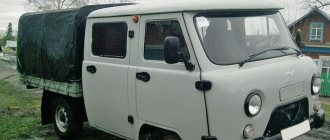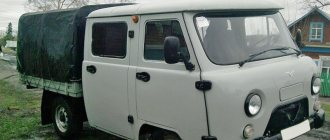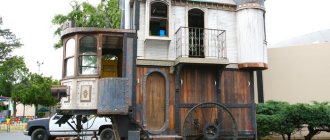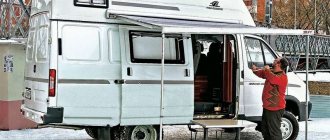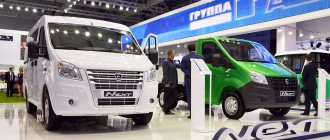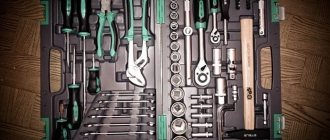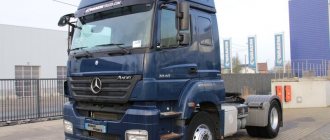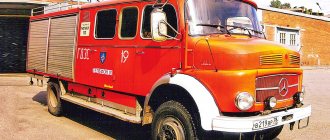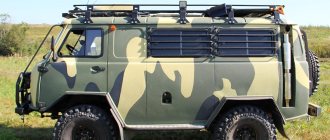Very big jeep
Daniil Minaev, photo by the author
| Manufacturer: | DAIMLER AG |
| Model: | Mercedes-Benz Zetros 2733A (6x6) 48 |
| Start of sales: | 2010 |
Paradox. In practice, a serial car officially supplied to our market turned out to be such a “rare bird” that getting it for testing turned out to be a matter of several months. After long negotiations and tedious waiting, I had at my disposal a three-axle chassis that had just arrived in Russia for further installation of a superstructure for a specific client. As a result, I have one day and a “naked” three-axle Mercedes-Benz Zetros.
Big "hood", but not "America"
From the first minutes of getting to know the car, when you are just walking around it, taking a closer look, adjusting the seat and steering wheel to suit you, it becomes clear that there are no parallels or hints of American “bonnet” cars or Russian “Urals”, Ukrainian KrAZ trucks and even Czech “Tatras” inappropriate here. This is a completely different car. And the comparison only suggests itself with the “Unimog”, as if it had been “inflated” to some incredible size. To prove my point, I discovered that the cockpit doors are definitely from a Unimog U5000. A familiar and fairly standard design solution, widely used in the truck industry. Remember, for example, the cabin of the ZIL-5301, which is better known as “Bychok”, and the cabin of the ZIL-4331. And what’s interesting: at the turn of the 1980s – 1990s, AMO ZIL built prototypes of army all-wheel drive vehicles on an updated chassis using the “4331st” cab. But it was a long time ago…
Deceiver
At first glance at the bonnet miracle from Wörth, it may seem that this is an extremely exclusive product with an original filling. But it is not so. Yes, in terms of production volume it should be comparable to heavy-duty vehicles Axor and Actros (which has not happened yet), and in terms of cross-country ability it should be on par with the Unimog model (which has happened). However, parts developed from scratch would not have the best effect on the cost of the car. And since the Zetros is a high-volume product, it received a lot of parts and components borrowed from other Mercedes-Benz models.
For example, he got the doors with electric windows from the Unimog U5000, the instrument panel from Axor, the frame (though reinforced) from the Actros Bau construction series. The design also contains elements from the Atego model. But whatever the components of the truck, they are all marked “made by Mercedes-Benz”, since they are manufactured at Daimler plants: a 6-cylinder in-line diesel engine in Mannheim, a 9-speed manual transmission and a two-speed transfer case in Hagenau and etc. Specialists from the Daimler Trucks plant assemble Zetros in Wörth, on the same line as Unimog and Econic.
The deception is also seen in the fact that Zetros has unnaturally small “eyes”. It would seem that such a monster doesn’t need eyes, but eyes, but it’s just a matter of size. The floodlight-type lenses he has shine - excellent. And they are small because they do not run the risk of damage from stones (by the way, an additional metal mesh with large cells is also provided for this purpose). And the headlights are set deep so as not to damage them when coming into contact with uneven roads and clearing debris - yes, Zetros is ready to clear the way from damaged or faulty equipment both in a combat zone, and during fires and at facilities liquidating the consequences of man-made disasters .
The AdBlue tank also confused me. It turns out that Euro 5 is the main, but not the only version of the car. There is also a Euro 3 version, naturally, without any urea. Simply put, outside of pampered Europe, Zetros is willing to put up with different rules of the game. But even on cars with an engine of the highest environmental standard today, the electronic control can be reprogrammed, which will allow the short-term use of diesel fuel with a high content of water and sulfur.
I saw another deception in the steel frame of the rear lights. Its functions are more decorative than applied. Apparently, this “chain mail” was invented to protect against stones, but not against encountering an obstacle. When “storming” the slides and descending from them at the factory site, the three-axle truck caught the ground several times, and this was enough for the metal shell to crush the lanterns like a vice crushes a nut shell. Without this “noose”, the lanterns would have bent back, but remained intact. And so additional costs for repairs are provided.
War is war, but comfort has not been canceled
There is no doubt that in front of me is a serious cargo SUV, which is also ready to put on a military uniform at any moment, but this did not stop me from sitting comfortably on the “pneumatically suspended” seat and adjusting the steering column for reach and tilt angle. To keep it cool, I turned on the air conditioning.
Feelings of static comfort are one thing, but they are doubly pleasant if they are complemented by convenient and responsive controls in motion. This is where the first comments appear. When I get used to a new, previously unfamiliar car, I do everything very smoothly, slightly touching, slightly pressing, smoothly operating the pedals, levers, and steering wheel. But here you can’t do that! The brake pedal is tight and not informative, although the deceleration (when you press it hard) is more than enough, and the trajectory is maintained well. The steering wheel reminded me of the good old Soviet buses - large in diameter, and you need to start turning it long before turning. Wait, I seem to have forgotten that I am driving a three-axle all-wheel drive truck with a curb weight of about 11 tons, I was just relaxed by the comfortable cabin...
Globalist
Overall, the car turned out to be convincing. Its focus on the global market is confirmed by the fact that a right-hand drive version will appear this year: the German “multi-machine operator” has attracted the attention of UK transport workers. Surely there will be other customers, otherwise why would the plant announce that at the end of 2010 a tandem hydraulic pump will be installed on the engine. This will expand the ability of the all-terrain vehicle to install additional equipment, and therefore increase its competitiveness.
To the previously listed areas of application of the Zetros, you can safely add a dozen or two possible professions for the German all-terrain vehicle. Even truck trial fans are eyeing it, and the only thing stopping them so far is the six-figure price tag, which will not become more affordable even in a crisis.
Gear selection, engine brake and rigid linkage
The complete opposite of purely “off-road truck” brakes and steering was the gearbox. There are a total of 9 running stages on two rows, not counting off-road locking, options for redistributing torque, and connecting a power take-off shaft. The first four gears are engaged “passenger-style,” then moving the lever to the right engages the elevated row. There is also an ultra-low forward gear, which allows you to move at walking speed (indicated on the gearshift lever by the symbol “C”). You can easily move away with an empty car and without damaging the clutch in 4th gear. The gearshift lever is not mechanically connected to the gearbox, so the effort on it is minimal, the clarity of engagement is excellent, and most importantly, smart electronics will not allow the transmission to break if you mistakenly engage a gear that is too low while driving. Interestingly, the gear shift algorithm uses the engine brake. The Zetros tachometer scale is traditionally marked in green in the optimal speed zone, then there is a yellow zone, after which there is a yellow-red and red zone of unacceptable speed. So, the yellow-red zone indicates the speed of maximum efficiency of the motor retarder.
In practice it looks like this. Before going down the hill, I shift down one or even two gears, “drive” the engine into the yellow-red speed zone and, at the same time taking my foot off the accelerator pedal, I apply the engine brake using the right steering column switch. The truck goes down smoothly without accelerating, without heating the pads and without consuming fuel. Fabulous! And all these body movements were not accompanied by shocks and impacts from the transmission. But when the moment comes before the climb to add more throttle so as not to “drop” the car closer to the top, then keep your eyes open! A sharp, inept operation of the right pedal will immediately make itself known with strong swaying and shaking, although the underloaded rear is partly to blame for this: the chassis is the chassis... Here you need to adapt to the oscillation frequency of the power unit and throttle it “in unison.” However, stop driving on the roads - this is not a mainline tractor.
Achtung! Partisan!
Under the hood of the Zetros is a straight-six with a potential of 326 horses, just waiting to be spurred on. But first you need to get used to it, since the interior of the cabin, even if you quickly identify it as a Mercedes-Benz, is still unfamiliar.
The first thing that surprises you is the huge diameter steering wheel. It turns out that the “trolleybus” solution is provided in case of hydraulic booster failure. What a failure there is: even with the power steering running, it’s not easy to turn it. And this is not the case when you can change the direction of movement with one hand. At high speeds on the highway, every now and then you have to steer a little, and when off-road you just have to make sure that the steering wheel doesn’t get torn out of your hands in a hole. Maybe I'm exaggerating, but that was exactly what my first feelings were.
Shifting on a manual gearbox is easy, and it’s especially nice that an empty truck allows you to start moving not only from 2nd, but also from 3rd and even 4th gear. Before switching to V, you need to make a swing movement to the right, otherwise you will remain on the downward row. I liked the clutch travel - it is quite predictable. It is also convenient to control the opening of the throttle valve with the gas pedal, but the response to fuel supply is not as quick as that of main-line models. Simply put, when starting from a standstill, you will definitely lose in a race with any of the road versions. And all this will happen to the accompaniment of the transfer case, which “weeps” at any speed while driving along the highway.
The indisputable advantage of the car is its powerful appearance. When approaching an intersection, other road users look at the Zetros in fascination. What can I say: when I approached the controlled intersection for the first time, it suddenly became clear that the car was difficult to stop. The first press on the brake pedal had no effect. The second time I pressed harder, but the “German” only slowed down slightly. At the same time, the multi-ton colossus was rapidly approaching the traffic light, where small cars were lined up in all rows. I will never forget the anxious look in the rearview mirror of the driver standing straight ahead of the VW Golf Cabrio: he was going to rush through the intersection on red, just to avoid getting hit. In the end, the “golfer” was ready to jump out of the car himself. But when I applied weightlifting force to the pedal, the Zetros began to effectively decelerate.
Another unpleasant surprise occurred when the instructor forgot to tell us to turn left. It was on a small two-lane highway. I said "yavol!" (I obey!) and, putting on the brakes, began to change the direction of movement. But it was not there! Even the truck, which had slowed down a lot, stubbornly refused to turn at an angle of 90°. We were close to missing the “knight’s move” and ramming the warning sign standing on the lawn. The instructor pressed his hands into the chair as if preparing to eject. There was genuine horror on the face of the careless driver of the old Opel, who jumped out from the junction...
But to the credit of German technology, it withstood the test of extreme situations. We took a difficult turn, not only without stopping, but without even leaving the roadway. The instructor’s heart was clearly relieved, and he said approvingly: “Zer gut, Alexander!” And then he asked the question of where I learned to drive a car, to which I answered without a second thought: “In the army, because I’m a reserve lieutenant colonel.” It turned out like in the joke about intelligence officer Isaev: “Müller asks: “Stirlitz, where did you get your license?” “In DOSAAF USSR,” he answered and thought: did I blurt out something unnecessary? The instructor didn’t say another word the whole way to the training ground, and I understand him...
How we wandered across the field
Whether I was lucky with the weather that day or not, I still haven’t decided. On the one hand, a clear sunny day created excellent conditions for photography, but on the other hand, the long dry weather left me with virtually no chance of finding a dirt road muddy from the rain. And thirdly, Zetros returned to the parking lot that day safe and sound, without any signs of a tractor chuck in the towing eyes, which is also important.
According to the recommendation of the Germans, before going off-road, I bleed the air from the air suspension of the driver’s seat by pressing a key and turn from the local asphalt road, first onto a compacted “grader”, which after a few kilometers turns into a dirt road, and then along the edge of the field I head towards the forest edge. If sometimes tractors drove across the field, then no car has definitely set foot here yet, but the ground is quite hard; and the German SUV is still completely indifferent to what is happening, it drives and drives, periodically crushing weeds and small bushes, and does not even ask to shift below fourth gear.
Stop, but here it gets more interesting. Recently, work was carried out to install poles with the help of which the as yet non-existent facility will be electrified. But they plowed up to great effect, and also “for a snack” a small swampy lowland at the edge of the forest. Now is the time to figure out how to manipulate the transmission using two elegant “twist handles” on the console on the driver’s right hand. The left handle is responsible for the locks, the right handle controls the transfer case.
As the chief trainer from MB TRUCK VOSTOK advised me, when going off-road, it is better to select the left position of the transfer case control handle in advance when stopping completely, where the pictogram shows a car on a hill. It corresponds to a 50% torque distribution between the front and rear axles. The position corresponding to the flat driving icon distributes torque in a ratio of 70% to the rear (as the most heavily loaded axles) and 30% to the front. This is more suitable for road driving. But I generally have a “bare” chassis, and the rear axles are underloaded, especially since I choose “50x50”! And I calmly drive out to the clearing that I like, “fenced off” by a small swamp.
It even became boring. Don’t expect loud sensations, because this is not a Bundeswehr testing ground, and no one will come to the rescue, even mobile communications, damn it, have disappeared somewhere. We need to be more careful. That’s it, I’ll drive over that shallow (about 80 centimeters to the eye) ditch with a muddy bottom and go home, because I’m responsible for the car with my head. But the groove turned out to be harmful. With a brave “wow,” I smoothly slid into it with the left front wheel, carefully hanging out, without meaning to, the rear right wheels, and just a little bit of the rear left one, according to the classic diagonal pattern.
It's time to "block" in a circle. But then what will happen to the turning radius, because this rather large car still needs room to maneuver, and, frankly speaking, I don’t have enough of it - there is dense growth ahead. The main thing is to get moving, and then I’ll figure it out. Now the gear marked with the letter “C” will definitely come in handy.
Started moving. Left. After two meters of the “path”, he stopped again, but on more or less flat and hard ground, fixed the car with the parking brake to disable the locks, and drove away.
Special carrier
The capabilities of this truck open up wide horizons for its application.
Yes, this is not just a cargo carrier, first of all it is a carrier of special equipment, and in places where not only there are no cars, but sometimes a person finds himself for the first time. Zetros was created for such operating conditions. And of course for the army. It can be a van, a shift truck, a dump truck, a truck crane, a drilling rig, a tanker truck, an airfield tanker and... anything where its owner needs to be, regardless of the availability of a road. In Europe, it is bought by rescuers, surveyors, utility workers and firefighters. In our country, he would undoubtedly have settled down in all these positions if he were not so dear. Zetros in Russia can be afforded by companies extracting oil, minerals and conducting geological exploration, but not everyone can afford them either. Sometimes it is ordered for ... hunting or fishing by people, to put it mildly, who are not too limited in funds, and they call it “a jeep, only a very large one.” Technical characteristics of Mercedes-Benz Zetros 2733A (6x6) 48
| Total weight, kg | 27 000 |
| Curb weight, kg | 10 500 |
| Load capacity, kg | 16 500 |
Engine:
| OM 926 LA – in-line six-cylinder, turbodiesel, I-6, Euro 5 7200 326 1300 at 1200 – 1600 min-1 |
| Transmission | Mechanical, 9-speed |
| Maximum speed, km/h | 90 |
| Brakes | Pneumatic, drum on all axes |
| Fuel tank capacity, l | 300 |
| Fuel consumption, l/100 km | 28–45 |
Cabin interior
It contains three comfortable seats - for the driver and two passengers. They are equipped with soft headrests and backrests that follow the curves of the body. The driver's seat has several degrees of adjustment. To the right of it, the gear lever is neatly located.
The front panel of the Mercedes-Benz Zetros is somewhat similar in design to the panels of truck tractors. It also curves smoothly in the middle, allowing the driver to easily reach the controls located on it.
The main instrument panel is located behind the steering wheel. Sitting behind the driver's seat, you get the impression that you are in the cockpit of an airplane - the car's control unit looks so technologically advanced and impressive.
Depending on the purpose, the interior can be made in gray tones. In this case, the chairs will be upholstered in soft fabric. The leather trim of the cabin in delicate brown tones and soft upholstery looks much more impressive. Having chosen a leather design, the driver will also acquire original leather bags on the door and under the glove compartment.
When the key hangs on a nail in the duty room
The number of victims of man-made disasters, plane accidents, fires and floods, and terrorist attacks would be lower if this courageous Mercedes were in the garages of our rescuers and firefighters. The fleets of these services traditionally use mostly domestic equipment. This is not the time or place to list the advantages and disadvantages of Russian cars, but all automotive experts know one “but” for sure. Whether it’s a ZIL or a KAMAZ, it is always alive and well in the hands of a skillful and not lazy driver, and when the “on duty”, “operational” or “emergency” crew waits for months to leave at the fence, and the keys hang on a nail in the control room, these are rather “fixed assets” enterprise" rather than a combat unit. Unlike Zetros...
Even a boy can climb onto the hood, this is facilitated by special design elements: ladders, handrails, handles, specially reinforced platforms for ease of access and maintenance of all points of the machine
Thing in itself
The comparison with the Ural, which some of my colleagues are so fond of making, is, in my opinion, unacceptable for Zetros. Firstly, they are in different weight categories: the “German” will be one and a half times heavier. Secondly, the level of comfort of a foreigner is higher: although this is not a passenger Mercedes, it is not a “oak” car for war in its purest form. Thirdly, their price range is also incomparable: for one Zetros you can buy half a dozen Urals. It would be more logical to compare the “Aryan” with the KrAZ, but I wouldn’t do that either: after all, the equipment is different.
The differences are visible even in the details. For example, getting into the Zetros cabin is more convenient. On the hood and bumpers of a German car there are areas coated with an anti-slip coating, but on Russian and Ukrainian cars there are none. The Aryan’s hood is not metal, but cast from fiberglass-reinforced plastic with additional heat treatment. There is an impressive hatch in the roof of the Zetros, which acts as an emergency exit in case of an accident, flooding or fire. In the same Ural, the hatches play the role of fresh air ventilation, through which it is impossible for an adult, especially with clothes on, to get out.
Production plagiarism
Another obstacle that casts doubt on the purchase of a Mercedes-Benz Zetros is its specificity, and, as a result, possible problems with the supply of spare parts. But here everything is completely different! Unification with other models of Mercedes-Benz trucks is no less than 70%! The engine - inline six - OM 926 is no longer a new product, and is of both Euro 3 and Euro 5 standards; the frame is borrowed from the construction Actros Bau, but strengthened, the dashboard is almost like an Axor, the steering of the MB LS 8 is only what I was able to see. Well, what about breaking drive axles with planetary wheel reduction gears? I don’t know what needs to be done to the car for this...
To civilian life!
Zetros were originally trained for military service. It’s not for nothing that prototypes of the car were presented in different sauces at specialized exhibitions of dual-use weapons and equipment throughout Europe. Experts focused on the hood layout, low silhouette and the ability of the truck to fit into the belly of transport aircraft and railway cars. The hood arrangement increases the crew's chances of survival if the front axle is blown up by a landmine. The low silhouette makes it easier to camouflage and makes it easier to move out of the enemy's fire zone. In addition, the angular shapes make it easier to armor the cabin. However, neither the Bundeswehr nor other NATO armies had the money to purchase Zetros. And it would be strange to rely solely on the fact that the truck will “put on shoulder straps” and become the most desirable among Western troops: in addition to Mercedes-Benz, army vehicles are produced by DAF Trucks, Scania, MAN and other manufacturers. Another thing is that there is only one bonnet among them.
However, everything in this world is relative. If a landmine that is too powerful is placed on the route, it will tear the truck apart, not only in parts, but also into molecules. And no hood will save you. Unfortunately, such examples are known from the experience of the counter-terrorism operation in Chechnya. Yes, and the armor is different. The one that was completed for Zetros by an African company only saves us from NATO bullets. If you hit an armored Kalash capsule with 7.62 mm bullets with a reinforced steel core, you won’t envy the crew, to put it mildly...
Among the massive purchases of all-terrain vehicles for military use, there is a well-known example of Canada, which purchased all-terrain vehicles for its contingent in Afghanistan. Single deliveries of weather do not contribute to the overall picture. The crisis generally eroded the initial plans, and the car began to be offered to civil organizations. On the eve of 2010, Finland purchased a batch of such all-terrain vehicles to service power lines. In general, Zetros can literally do everything: be a builder and a rescuer, a rotation bus and a fire truck, a repair truck and an emergency tractor, a cash collector and a mobile laboratory, a technical support vehicle and a fuel tanker. This is a reliable chassis for mounting ladders, drilling rigs, telescopic lifts, cranes and utility equipment. The all-terrain vehicle can operate in conjunction with heavy trailers: up to 30 tons in a 4x4 configuration and up to 40 tons in a 6x6 design. If necessary, it can easily replace a tractor, and in some cases it will even outperform a helicopter in efficiency. In general, the scope of its application is almost limitless.
